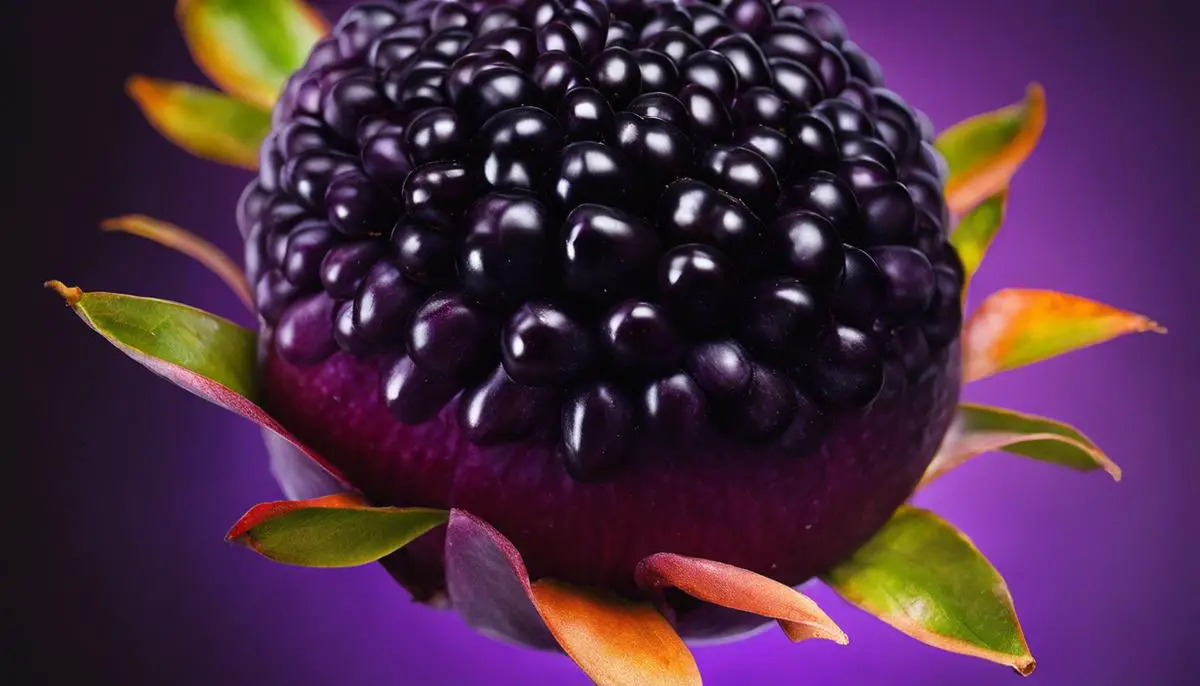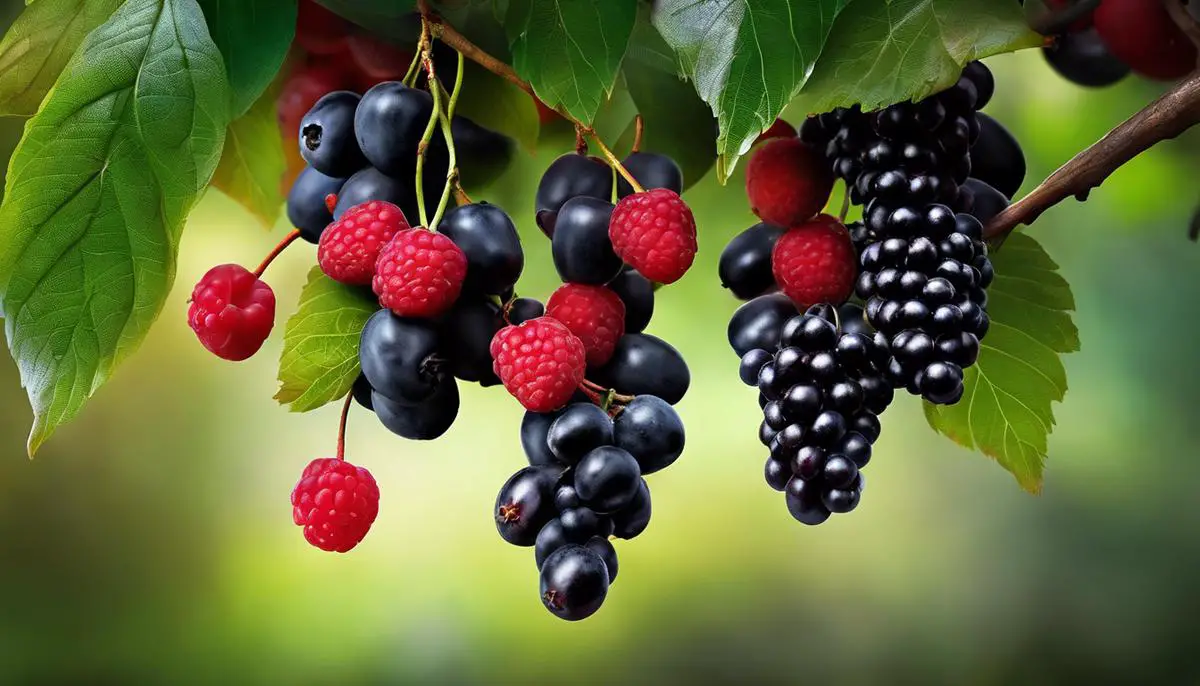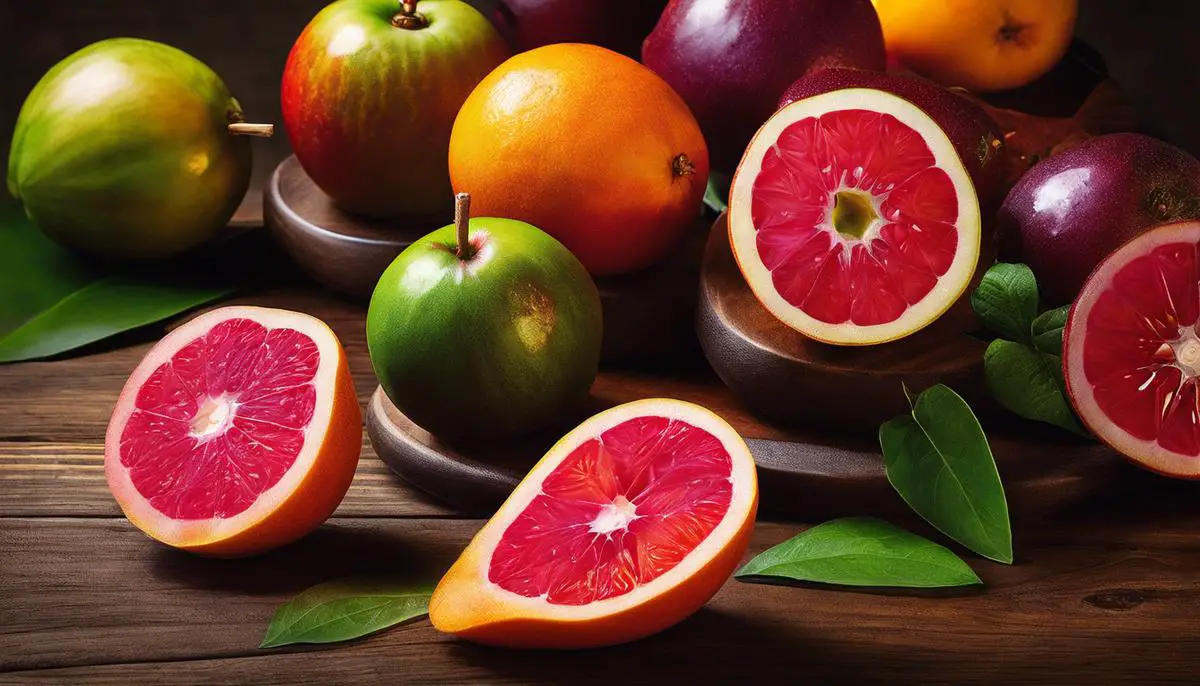
Syzygium cumini, commonly known as Jambolan or Jamun, is an underexplored berry-like fruit rich in an array of phytochemicals and medicinal properties. This tropical delicacy, which burgeons predominantly in the Indian subcontinent, is often revered for its characteristic purplish hue and unique taste profile. Yet, peek beneath its unassuming exterior, and one discovers a wealth of biological compounds, like anthocyanins and phenolic compounds, known for profound health benefits. This essay will navigate you through the complex nutritional maze of Jambolan, shedding light on its health-centric benefits and pharmacological applications. However, while we extol its virtues, we shall not forget to amp up the cautionary note about any potential risks and side effects linked to its consumption.
Phytochemical Composition of Jambolan Fruit
“The Vital Phytochemicals of the Jambolan Fruit: An Illuminating Peek into this Tropical Delight”
The Jambolan fruit, widely recognized as Syzygium cumini, extends a wealth of untapped phytochemical potential. The underappreciated values hidden beneath its dark purple rind are only lately attracting deserved attention within the scientific community. A nexus of diverse wondrous chemicals makes this tropical treasure a focal point in nutraceutical research — compounds often suppressed behind the flavor and appealing color of this exotic fruit.
Anthocyanins, a group of water-soluble pigments, are among the foremost phytochemicals present in the Jambolan fruit. They equip the fruit with its vibrant purple color while simultaneously combating oxidative stress through their potent antioxidant properties. The balance they strike between allure and biological benefit is, indeed, exceptional.
The noteworthy lignan content of the Jambolan fruit also warrants a closer examination. This class of polyphenols presents a remarkably wide range of bioactivities including anti-inflammatory, antioxidant, and antitumor effects — truly a crucial frontrunner in the battle against disease-promoting free radicals.
Distilling the Jambolan further, we encounter a wealth of flavonoids, another noteworthy phytochemical. Flavonoids, teeming with health-enhancing properties, add to the remarkable roster of nutrients bound within this tropical edible. They exhibit a plethora of beneficial effects, among which antioxidant, anti-allergic, anti-cancer, and anti-inflammatory activities are prominent.
Delving deeper, one also uncovers an exciting reserve of essential minerals and vitamins, namely Vitamins C & A. These vital nutrients, in tandem with the aforementioned phytochemicals, contribute to the Jambolan fruit’s notable antioxidant prowess.
At the heart of this investigation, perhaps the most notable feature of the Jambolan fruit is the presence of a unique naturally occurring compound known as jamboline. It holds a place of honor for its potential to regulate blood sugar, marking the fruit as a potential ally against diabetes.
In essence, the Jambolan fruit houses a tapestry of vital phytochemicals whose full spectrum of healthful potentials are just beginning to be appreciated. For those intrigued by the nutritional possibilities hidden within this understated fruit, these early insights lead the direction towards a deeper understanding and appreciation — an intriguing journey, one full of enlightening discoveries in the boundless realm of nutrition science.

Health-Centric Benefits of Jambolan Fruit
The beneficial impact of Jambolan fruits on human health extends to their potential in enhancing digestion. Rich in dietary fiber, the fruit assists in the smooth propulsion of food through the gastrointestinal tract. Consumption of dietary fiber offers a multitude of health benefits including the prevention of constipation, hemorrhoids and colonic diseases.
Furthermore, Jambolan fruit exhibits significant diuretic properties, promoting urinary activity and consequentially aiding in the flushing out of toxins from the body. This detoxification process improves kidney function and reduces the risk of numerous urinary complications such as kidney stones and urinary tract infections.
Another valuable contribution of the Jambolan fruit is in maintaining cardiovascular health. Its low sodium and high potassium content work synergistically to regulate blood pressure levels. Potassium is a vasodilator, causing the dilation of blood vessels and thus reducing strain on the cardiovascular system. This mechanism help in the prevention of conditions such as atherosclerosis, heart attacks, and strokes.
The Jambolan fruit is also serving in the war against microbial infection. Some studies have illustrated the fruit’s antimicrobial potency especially against specific bacteria and fungi. These antimicrobial constituents interfere with pathogen growth and multiplication, thus providing a natural defense against infectious agents.
Jambolan fruit also bears relevance in the field of dental health. Its bark and leaves have been traditionally used in oral health practices. The fruit’s antimicrobial nature combats oral pathogens thereby preventing dental cavities, gingivitis, and periodontal diseases.
The Jambolan fruit, as emerging evidence so gracefully highlights, provides a natural and effective route to improved overall health. It is a cornucopia of essential nutrients, phytochemicals, antioxidants, and health-promoting compounds. As the scientific community continues to unearth the bounty of the Jambolan fruit, it is bound to assume a more prominent role in nutritional and health science.

Pharmacological Applications of Jambolan
Historically known as a treasure trove of utilized benefits in the Eastern world, the Jambolan fruit’s pharmacological value is also becoming increasingly acknowledged by Western medicine. With roots tracing back to the Indian Subcontinent, Jambolan has earned a revered space in traditional medicine, and is poised to do the same within the realms of modern pharmacology.
A key aspect of interest in traditional medicine is the Jambolan fruit’s effects on the gastrointestinal system. As an aid in digestive disorders, this fruit is believed to alleviate dysentery and other similar conditions due to its astringent properties. Current scientific evidence supports the traditional use of Jambolan in enhancing digestion and protecting against various digestive issues, generating a synergistic bridge between ancient wisdom and modern understanding.
Jambolan’s diuretic and detoxification benefits further elevate its pharmacological importance. Its diuretic properties particularly, assist in the removal of toxins, excess water, and salts from the body. In a world where detox diets are on the rise, the scientifically backed detoxification properties of Jambolan represent a natural and wholesome approach to bodily purification.
From a cardiovascular standpoint, the Jambolan fruit plays an active part in the maintenance of heart health and regulation of blood pressure. Ancient medicinal practices hail it as a cardiac tonic, and modern science has started diving into the mechanisms through which Jambolan contributes to cardiovascular health, again cementing the timeless value of traditional medical knowledge.
In conjunction with antimicrobial capabilities, Jambolan shows proven merit against pathogens such as bacteria, fungi, and yeast, presenting an exciting line of defense against various infectious diseases. Pioneering research is gradually dissecting the complex microbial interactions which enable these defensive properties.
Furthermore, a less commonly spoken about attribute of this fruit is its prevalence in oral health. Dental issues historically treated with Jambolan include gum infections and mouth ulcers. Current studies indicate that the antimicrobial properties of Jambolan can aid in the prevention of oral diseases, rounding its medicinal portfolio with a touch of dental relevance.
The exploration of Jambolan’s nutrient-rich profile and its various health-promoting compounds facilitates an understanding of this fruit that transcends cultural and temporal boundaries. It is vital, therefore, that we continue to bridge the gaps between traditional wisdom and modern scientific understanding, further unlocking the extensive potential of this remarkable fruit. In doing so, the world stands to benefit from the vast pharmacological resources found in nature’s simplest yet most profound offerings.

Potential Risks and Side Effects of Jambolan Fruit
Delving further into the Judicious Jambolan Journey
As with any good thing, moderation is key and the consumption of Jambolan fruit is no exception. Despite its abundant health-promoting properties, the enthusiastic intake of Jambolan fruit could have potential risks and side effects, which is worthy of a scholarly probe.
One of the risks associated with the intake of Jambolan fruit includes possible allergic reactions. Though rare, some individuals may have a sensitivity to this fruit and its compounds. Common symptoms of fruit allergies include hives, skin rashes, itching, swelling of the lips or tongue, difficulty in breathing, and in severe cases, anaphylaxis. If any allergic reaction is suspected, it is advised to seek immediate medical attention.
Moreover, the beneficial blood sugar regulating abilities of Jambolan can turn into a double-edged sword. Individuals with diabetes who are on antidiabetic medications, should be cautious as the hypoglycemic effect of the fruit might potentiate the blood sugar lowering action of these drugs, leading to an undesirable low blood sugar condition called hypoglycemia.
Also, considering its diuretic properties, overconsumption of the Jambolan fruit might lead to frequent urination. This could potentially affect critical electrolyte balance, cause dehydration and even disturb sleep patterns due to nocturnal visits to the restroom.
Furthermore, pregnant and breastfeeding women are generally advised to practice caution. Although no specific studies indicate any harmful effects of Jambolan fruit in these populations, due to the lack of comprehensive research in this area, it is recommended to consult healthcare providers before including Jambolan fruit in their diet.
In line with this, individuals scheduled for surgeries are often recommended to avoid consuming Jambolan fruit weeks prior to their procedure. The fruit’s potential impact on blood glucose levels could interfere with blood sugar control during and after surgery.
In conclusion, although the risks and side-effects associated with Jambolan intake are relatively minor and rare, knowledge of the same signifies the importance of balanced consumption, and attests to the adage about there being ‘too much of a good thing’. As responsible consumers and enthusiasts of nature’s bounty, understanding the full realm of this marvelous fruit – the good and the not-so-good, endows us with the power to use it optimally and responsibly. A continued exploration of these paths of research may gradually unveil more insightful testimonies to the duality of Jambolan, and other remarkable fruits of nature.

Arming oneself with information is key to safe and healthy lifestyle choices. As we have traversed the in-depth knowledge about Jambolan, one thing is clear – this humble berry is a powerhouse of nutrients like dietary fiber, essential minerals, and vitamins, offering tangible health benefits. Its potential role as a natural antimicrobial agent, its application in managing diabetes and possible cancer prevention serve as a testament to its curative prowess. However, keeping an open eye to potential risks cannot be undermined- it is a crucial step towards appreciating this fruit in its totality. Ultimately, the Jambolan fruit stands as a wonderful emblem of how nature’s gifts can be harnessed for human health, provided we approach them with informed discretion.



